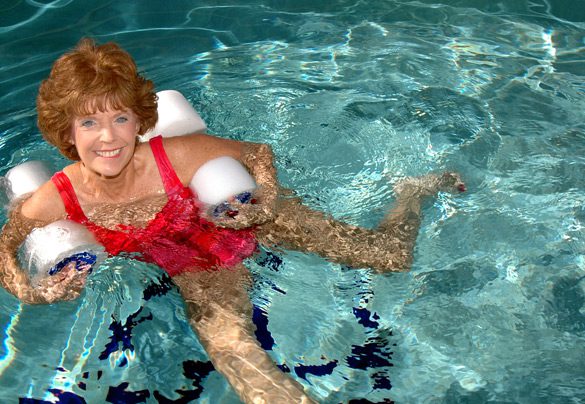Pool physical therapy is a therapeutic technique involving specific exercises usually performed in a heated pool. By taking advantage of water’s natural buoyancy and the warmth of the pool water, many people with persistent pain and discomfort are able to exercise without aggravating muscles. It’s a form of therapy often recommended for patients with musculoskeletal and neuromuscular conditions such as arthritis, sciatica, and non-specific low back pain.

Who Benefits from Pool Physical Therapy?
Pool PT may benefit almost anyone who has difficulty performing therapeutic exercises on land. Exceptions include individuals with an extreme fear of water, open sores or wounds, and certain medical conditions. Therapy sessions in water also provide a safe environment to improve posture and increase muscle strength. Pool physical therapy may benefit patients with:
- Sports-related injuries
- Orthopedic disorders
- Chronic pain
- Limitations due to personal injuries
- Conditions affecting balance
How Pool Physical Therapy Works
The unique properties of water decrease compression forces that sometimes make it difficult to perform beneficial exercises. Pool physical therapy is often combined with traditional land-based therapy and some patients transition back to land sessions only after they’ve improved or healed. Patients are typically assessed with standard diagnostic tests to determine how to structure pool sessions. Special equipment with a wider surface area is often used. Assistance devices may also be used during sessions. A flotation belt may be worn to create more resistance.
Patients may start with simple water-based exercises such as walking from one side of the pool to another. Leg lifts may be performed while balancing against a wall or receiving assistance from a therapist. The higher the water, the greater the resistance felt. Patients who are new to pool PT often find it more comfortable to start in water that’s somewhere between waist and chest level, which provides both resistance and balance.

Results Often Experienced from Sessions
The warm water of the pool relaxes muscles and the buoyancy of the water reduces the feeling of weight and pressure. Participants often enjoy a greater sense of comfort and mobility when performing exercises in the water. Although individual experiences with pool therapy will vary based on abilities and the specific conditions or limitations of each patient. Many individuals report:
- Better joint flexibility
- Reconditioning of weakened muscles
- Noticeable pain relief
- Improved balance and coordination
- Increased circulation
Preparing for Pool Therapy Sessions
Participants usually wear a bathing suit, shorts, or loose clothing that won’t become too heavy when wet. Comfortable shoes should also be worn. Patients who will need assistance getting changed or getting in and out of the pool may be asked to bring a caregiver to sessions.
It’s not necessary to know how to swim to take part in pool physical therapy session. Depending on the setup of the pool, the water can be accessed by stairs or a ramp. Before sessions begin, goals will be established and progress will be tracked from session to session. Many patients are able to participate more in land-based sessions due to the benefits of pool physical therapy.
